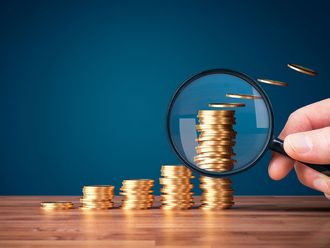
Dubai: If you're at the brink of leaving your job for good, you may be considering early retirement. And if you’re a fan of the ‘FIRE’ (Financial Independence, Retire Early) movement, you will likely like the idea of piling up assets like stocks and real estate and diversifying your income streams so you can retire early!
But realistically, that can take a whole lot of time and effort and for most of us, we won't be able to retire early or even explore the possibility of a drastic career change. But what if there was a much easier way to get out of your current employment? That is where a ‘FU fund’ comes in!
It is essentially a bridge that helps you transition from a place of hardship and stress to a place of financial stability. When you have enough money set aside, for a date of your choosing, you quit!
UAE-based financial planners have often walked us through offered various rules of thumb about how much you need to save, be it somewhere near Dh1 million, 80 to 90 per cent of your annual income or 12 times the salary you earned right before you bid farewell to the workforce for good.
But what amount hits the sweet spot for you? And how do you know you're on track to said amount? Because there are so many variables, even the same retirement researchers can't agree on a total amount. What each person needs will vary widely based on a few factors.
#1 - FU fund enough for income you'll need after retirement?
“You may be surprised how much — or how little — even generously-sized accounts could potentially provide over retirement post-resignation. The examples below illustrate how much a 65-year-old can safely withdraw in the first year of retirement,” explained Abu Dhabi-based financial planner Andrea Barbara.
“If you have saved up Dh300,000 at age 65, then that implies your annual retirement income from savings is Dh12,000 per year. If you have saved up Dh1 million, annual retirement income from savings is Dh40,000 each year. If the value of your savings at age 65 is Dh1.5 million, your annual income from savings is Dh60,000 a-year.
"Just how big your nest egg should be and how long it might last will depend not only on what you save in your FU fund and invest, but also on how you spend it once you do retire." Here are some more factors to consider as you determine what your unique savings goal should be.
#2 - Estimate your savings based on what you expect to spend
“While having a percentage amount to give you a rough idea for planning can be helpful, you can't be focused solely on that,” explained Dubai-based money coach Mirin Raul.
“With everybody's lifestyle is different, what they want to do in their post-employement years may be very different as well. Rather than rely on a general figure, they suggest trying to create a ballpark annual estimate based on what you live on now and what might change when you retire from the workforce or consider a drastic career change.”
For instance, if you have a large amount of debt that you need to pay off before you even think of quitting your job and launch a business, you can set your percentage-based budget. For instance, put 60 per cent of your income towards your needs (including debts), 20per cent towards your wants, and 20 per cent towards your savings.
#3 - Knowing how you will spend your FU fund or retirement pot
Here's what statistics show on how people today generally spend their money right before they retire or permanently quit being employed before say starting a business or making a drastic career change, according to a survey of those aged between 50 to 85 years.
While they spend about 44 per cent to 48 per cent of their money on housing, food expenses average at 12 per cent to 14 per cent, and clothing costs averaging at 3 per cent to 4 per cent. While transportation and entertainment expenses reduce, the former costs 7 per cent to 14 per cent of your FU fund or savings pot, while the latter, being entertainment costs, ranging within 6 per cent to 11 per cent.
“Remember, although some costs may increase over time, there may be savings elsewhere. Researchers have found that once people retire they spend more time shopping carefully and preparing meals at home, for example. Their cost of living for items such as these goes down,” Barbara added.
"With an albeit larger-than-size FU fund, you have the option to take a better breather to decide what you want to do next. So the goal then is to save enough that allows you to take an extended time off before returning to work, and not just stash away four months of your salary before forgetting about it."
Working in retirement: expectations versus reality
"To build an FU fund, first start by looking at your budget. This means knowing what your currently cash flow (income) is, what your expenses are, and what amount of money you can save each month towards your FU fund," explained Barbara.
"If you're planning to work in retirement so you can save less today, be realistic about expectations." An annual global Retirement Confidence survey has consistently found that workers are far more likely to expect to work in retirement than actually end up doing so.
In their last published report, about 80 per cent of respondents planned to work in retirement, compared with just 30 per cent of retirees who report they have worked for pay in retirement.
For a quick check of how you're doing today versus similar savers:
“Just as it can be helpful to see how your heart rate, blood pressure or weight compare to the ‘norm’ when you get your annual physical health check-up, you can now assess how your FU fund or retirement savings stack up against your peers by using ‘Net Wealth to Income Ratio’ calculators provided by several banks, both regionally and worldwide,” added Raul.
Raul further explained that by using the calculation from renowned US-based investment and wealth manager Merrill, you canfind out how much the best savers and investors have set aside as a proportion of their current salary. "Based on the Merrill calculation, the best FU fund or retirement savers — those whose savings are greater than 90 per cent of people in their age and salary range — have saved a total of:
“For those ages 18-29, the amount is 0.7 times their current salary and for those ages 30-39, the amount is 1.3 times their current salary. For those ages 40-49 the amount is 2.8 times their current salary and for those ages 50-59 the amount is 4.9 times their current salary. For those ages 60-64 the amount is 7.4 times their current salary.
"For example, if 39-year-old Jane, who earns Dh120,000 a year, wants to see how her savings measure up to the best savers in her age group, she would just multiply her current salary by 1.3 and compare that to her current savings. Thus, to keep up with the savers and investors in her peer salary group, she would need to have saved Dh156,000 (Dh70,000 x 1.3) so far."
Next? See if there is a gap between what you'll have and what you'll need
To see where you are and what you can change to stay on track for the future, retirement calculators also let you view a projection of your savings to see if there is a gap between what you'll have and what you'll need when you finally retire, and it helps you adjust your strategy accordingly.
“With a calculator, you can see how potential adjustments to your FU fund, retirement date, and investment choices can affect the size of your retirement savings in the future,” Barbara added.
However, even if the checkpoints listed above show that you're behind where you might be, don't get discouraged by the big numbers you may see, she advised. “Whatever you save and invest today for the long term can make a big difference in the future. If you need to save more, even a 1 per cent increase can mean a lot over time,” she said.











